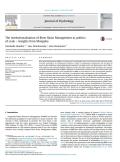Once again, the international community focuses on the preservation of Amazonian forests, in particular through a bundle of initiatives grouped under the term of REDD+. Initially focusing on reducing carbon emissions, the REDD+ process became increasingly linked with developmental goals that represent the primary interest of all Amazon countries. In consequence, REDD+ can be seen as another attempt to achieve the twin goals of environmental protection and rural development, and consequently, relies on the strategies and tools of past efforts. Against this background, we explore past experiences with key strategies for environmental protection and poverty alleviation in the Amazon to critically reflect about the potential of REDD+ to contribute to sustainable local development in the region. The analysis demonstrates that initiatives that pursued environmental goals mostly led to more restrictions and bureaucratic barriers to local forest users, while the prevailing approaches to promote rural dwellers showed ambivalent environmental outcomes.

There is more to sustainable forest management than reduced impact logging. Partnerships between multiple actors are needed in order to create the institutional context for good forest governance and sustainable forest management and stimulate the necessary local community involvement. The idea behind this is that the parties would be able to achieve more jointly than on their own by combining assets, knowledge, skills and political power of actors at different levels of scale. This article aims to demonstrate by example the nature and variety of forest-related partnerships in Brazilian Amazonia. Based on the lessons learned from these cases and the authors’ experience, the principal characteristics of successful partnerships are described, with a focus on political and socioeconomic aspects. These characteristics include fairly negotiated partnership objectives, the active involvement of the public sector as well as impartial brokers, equitable and cost-effective institutional arrangements, sufficient and equitably shared benefits for all the parties involved, addressing socioeconomic drawbacks, and taking measures to maintain sustainable exploitation levels.

River Basin Management (RBM) as an approach to sustainable water use has become the dominant model of water governance. Its introduction, however, entails a fundamental realignment and rescaling of water-sector institutions along hydrological boundaries. Creating such a new governance scale is inherently political, and is being described as politics of scale. This paper analyzes how the politics of scale play out in the institutionalization of RBM in Mongolia. It furthermore scrutinizes the role of the broader political decentralization process in the introduction of RBM, an issue that has so far received little attention. Finally, it assesses whether the river basin is an adequate water management scale in Mongolia.
Anthropogenic climate change is a formidable global challenge. Yet countries’ contributions to global greenhouse gas emissions and the climate change impacts they face are poles apart. These differences, as well as countries’ different capacities and development levels, have been internationally acknowledged by including the notion of Common But Differentiated Responsibilities (CBDR) and Respective Capabilities under the 1992 United Nations Framework Convention on Climate Change (UNFCCC).
